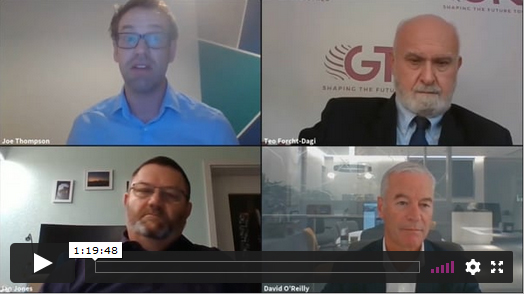
The second panel discussion during the 2020 GTNF in the Asia time zone featured top scientists from the leading tobacco companies discussing the role of science in the tobacco and nicotine business.
Moderated by Teo Forcht-Dagi, honorary professor at Queens University, the panel included Maria Gogova, vice president of regulatory sciences and regulatory affairs at Altria Client Services; Ian Jones, R&D principal scientist at Japan Tobacco International; David O’Reilly, director of scientific research for British American Tobacco; and Joe Thompson, chief scientific officer at Imperial Brands.
Asked to identify the most salient scientific issues facing the tobacco and nicotine industries, the panelists named the communication of science and data gaps, among other topics.
Today’s alternatives to combustible products represent an unprecedented opportunity to reduce the risks of smoking, but without consumer trust in the product, the opportunity will not live up to its potential.
Jones summarized the challenge by quoting Anne Roe. “Nothing in science has any value to society if it is not communicated,” the American psychologist reportedly said. “It helps if it’s understandable too,” Jones added, quoting a coworker this time.
Despite the substantial and growing body of evidence that vaping is less harmful than smoking, an increasing number of consumers believes the opposite. Between 2014 and 2016, the share of U.S. adult smokers who perceived vaping as being equally or more harmful than smoking increased from 44 percent to 68.4 percent, according to the PATH study.
Such misconceptions are fueled by flawed studies and sloppy media coverage, according to Thompson. For example, a 2019 research paper erroneously linked e-cigarette usage among adults to heart attacks, generating sensationalist headlines. Its authors were later forced to retract the study, but by that time, the damage in terms of public perception had been done.
O’Reilly noted that most people’s understanding of tobacco and disease is about 30 years out of date, causing them to confuse nicotine with products of combustion. He said it was depressing to see how even many medical and scientific professionals misunderstand the issues, mistakenly attributing cancer and respiratory diseases to nicotine, for example. “It is one thing for the public to struggle with nuances of nicotine toxicology, but the misperceptions of our colleagues in [the] scientific and medical world must be addressed,” he said.
The panelists agreed the industry should step up its science communications and use all available channels (while noting that some channels are off-limits) to get its message across. Jones called on the industry’s communicators to be open, transparent and take the time to understand their audience. “Don’t sit on your pedestal and try to bedazzle everybody,” he said. O’Reilly said the automotive industry provided a good analogy to describe the tobacco industry’s transformation to the public. “Moving away from combustion will benefit public health,” he said.
The panel then turned its attention to data gaps—what we don’t know. A recent review by the Committee on Toxicology that advises the U.K. Department of Health was broadly supportive of vaping but also pointed to the lack of information on the performance of cigarette alternatives over time. This presents a challenge not only because of the sector’s age—many products simply haven’t been around for long enough to conduct epidemiological studies—but also because it is hard to follow people over time. Contrary to the traditional cigarette business where smokers typically stay with the same product and brand for the duration of their smoking “career,” vapers change products frequently, either due to evolving technology or changing preferences. So tracking them is difficult.
While acknowledging the data gap, Gogova said the absence of epidemiology should not be used as an excuse to foreclose tobacco harm reduction opportunity and/or the authorization of modified-risk claims, as doing so would leave the field to combustible cigarettes—the riskiest option.
Despite the relative youthfulness of the vapor sector, O’Reilly said it was time to start considering population-based studies. “We are in a different space today then at the start of the GFNF in terms of science. In a number of countries, the uptake of alternative products has been going on for some time now.”
The panel also pondered the question of how to recruit scientists. Fortunately, the industry’s transformation has made that task easier in recent years. Many scientists are attracted by the opportunity to help reduce the harm caused by smoking. According to O’Reilly, scientists could arguably do more to avoid a billion premature deaths by joining the tobacco industry than by signing up for academia or other sectors. As Jones explained,” science is about curiosity, about wanting to learn more, ask questions and pull things to pieces to see how they work.” Unlike the situation 20 to 30 years ago when tobacco science had stagnated, the transformation that the industry is undergoing provides all of that.
Encouragingly, all panelists reported that scientists today have a big seat at the table inside tobacco companies’ board rooms. Science is viewed as fundamental, they said. It makes sense: One of the greatest challenges to sustainability for the industry is achieving tobacco harm reduction that is based in sound science. Without science, the industry has no foundation to transform itself and continue its operations.










